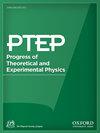Production Cross Sections of Residual Nuclides from 93Zr + p at 27 MeV/Nucleon
IF 8.3
4区 物理与天体物理
Q1 Physics and Astronomy
引用次数: 0
Abstract
Nuclear transmutation emerges as a promising approach for reprocessing high-level waste, specifically treating long-lived nuclides like 93Zr from spent fuel. It is essential to accumulate reaction data for these nuclei to advance this prominent treatment and to build a comprehensive understanding of reaction mechanisms. In this study, the residual production cross sections resulting from proton-induced reactions on 93Zr were measured at 27 MeV/nucleon in inverse kinematics. At the RI Beam Factory (RIBF) the OEDO beamline was used to deduce production cross sections for isotopes, 91 − 93Nb, 91, 92Zr, and 88, 89Y. Comparing the results from this study and prior research with calculated excitation functions, a moderate agreement is found with theoretical predictions derived from TALYS and CCONE. The measured cross sections offer valuable insights for future considerations in nuclear-waste treatment facilities. This is particularly relevant for facilities exploring innovative methods, such as accelerator-driven systems.在 27 MeV/核子频率下 93Zr + p 产生残余核素的生成截面
核嬗变是对高放射性废物进行后处理,特别是处理乏燃料中 93Zr 等长效核素的一种很有前途的方法。积累这些核素的反应数据对于推进这一重要处理方法和全面了解反应机制至关重要。在这项研究中,以 27 MeV/核子的反向运动学测量了 93Zr 上质子诱导反应产生的残余生成截面。在里约热内卢光束工厂(RIBF),利用 OEDO 光束线推导出了 91 - 93Nb、91、92Zr 和 88、89Y 等同位素的产生截面。将这项研究的结果与之前通过计算激发函数得出的研究结果进行比较,发现两者与 TALYS 和 CCONE 得出的理论预测结果基本一致。测量的横截面为核废料处理设施的未来考虑提供了宝贵的见解。这对于探索创新方法(如加速器驱动系统)的设施尤为重要。
本文章由计算机程序翻译,如有差异,请以英文原文为准。
求助全文
约1分钟内获得全文
求助全文
来源期刊

Progress of Theoretical and Experimental Physics
PHYSICS, MULTIDISCIPLINARY-PHYSICS, PARTICLES & FIELDS
CiteScore
12.00
自引率
5.70%
发文量
148
审稿时长
17 weeks
期刊介绍:
Progress of Theoretical and Experimental Physics (PTEP) is an international journal that publishes articles on theoretical and experimental physics. PTEP is a fully open access, online-only journal published by the Physical Society of Japan.
PTEP is the successor to Progress of Theoretical Physics (PTP), which terminated in December 2012 and merged into PTEP in January 2013.
PTP was founded in 1946 by Hideki Yukawa, the first Japanese Nobel Laureate. PTEP, the successor journal to PTP, has a broader scope than that of PTP covering both theoretical and experimental physics.
PTEP mainly covers areas including particles and fields, nuclear physics, astrophysics and cosmology, beam physics and instrumentation, and general and mathematical physics.
 求助内容:
求助内容: 应助结果提醒方式:
应助结果提醒方式:


